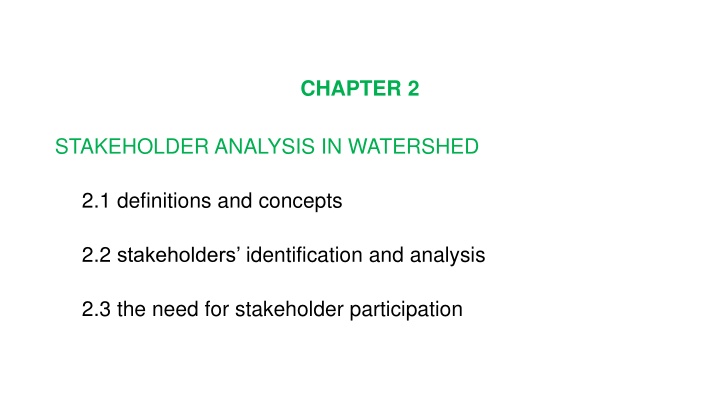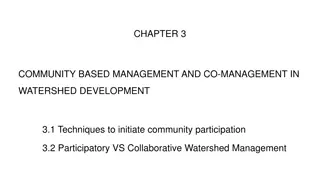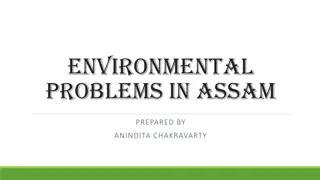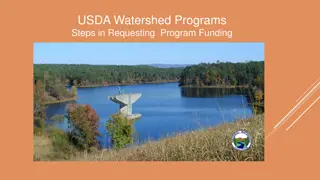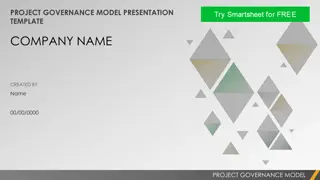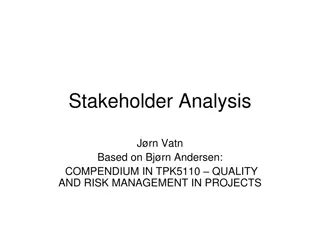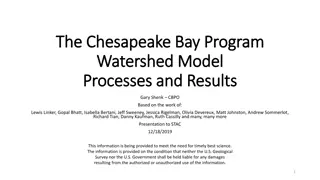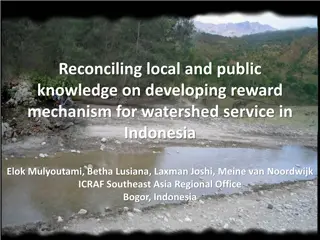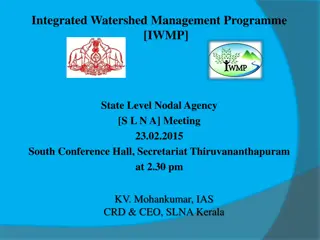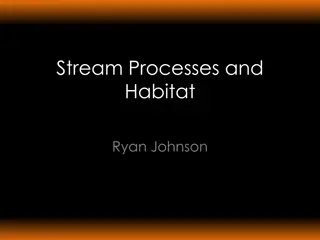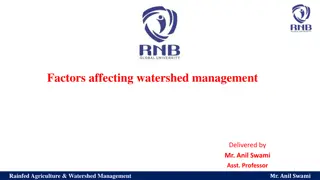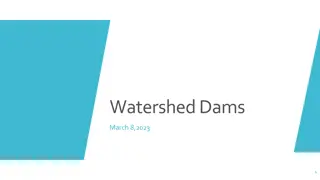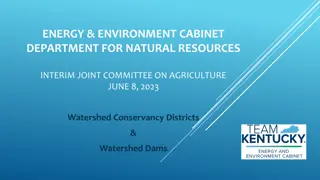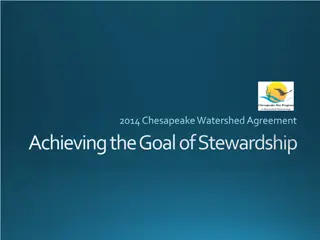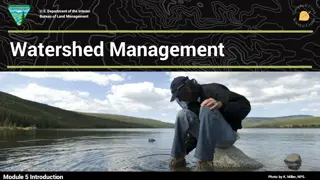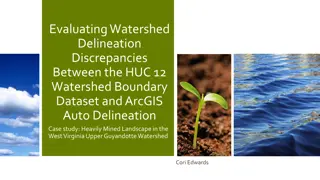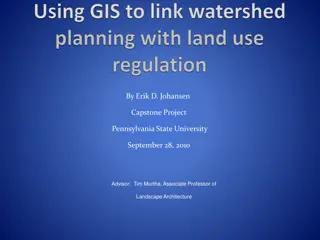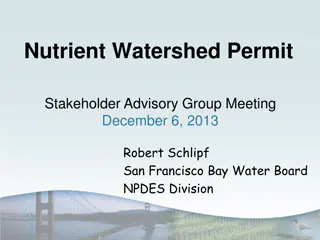Stakeholder Analysis in Watershed Management
Stakeholder analysis is crucial for effective watershed management. Understanding the interests and impact of various stakeholders, from local communities to international organizations, helps in forming partnerships and promoting sustainable development. Learn about stakeholder definitions, identification, and the importance of stakeholder participation in this comprehensive guide.
Download Presentation

Please find below an Image/Link to download the presentation.
The content on the website is provided AS IS for your information and personal use only. It may not be sold, licensed, or shared on other websites without obtaining consent from the author.If you encounter any issues during the download, it is possible that the publisher has removed the file from their server.
You are allowed to download the files provided on this website for personal or commercial use, subject to the condition that they are used lawfully. All files are the property of their respective owners.
The content on the website is provided AS IS for your information and personal use only. It may not be sold, licensed, or shared on other websites without obtaining consent from the author.
E N D
Presentation Transcript
CHAPTER 2 STAKEHOLDER ANALYSIS IN WATERSHED 2.1 definitions and concepts 2.2 stakeholders identification and analysis 2.3 the need for stakeholder participation
Before studying about stakeholders it is better to read and understand about partnership in watershed management Hence you are expected to read about partnership from Building local partnership (A Guide for Watershed Partnerships) oWhy build a local partnership. oWho should be included? oHow to build a successful partnership oWhy partnerships succeed. oWhy partnerships fail. oHow to build consensus. oOn other topics
Basic concepts and definitions Who is a Stakeholder? A stakeholder can be defined as: Any individual, group, or institution who has a vested interest in the natural resources of the project area and/or who potentially will be affected by project activities and have something to gain or lose if conditions change or stay the same stakeholders are defined as the people and organizations who are involved in or affected by an action or policy and can be directly or indirectly included in the decision making process A stakeholders for its projects particular organization may further define situation-specific groups of
For example, the United Nations Environment Program identifies and engages with nine specific major stakeholder groups for sustainable development projects under their oversight farmers, women, scientific and technological community, children and youth, indigenous peoples and their communities, workers and trade unions, business and industry, nongovernmental organizations, and local authorities
the term stakeholders to mean any group of people, organized or unorganized, who share a common interest or stake in a particular issue or system; they can be at any level or position in society, from global, national and regional concerns down to the level of household or intra-household, and be groups of any size or aggregation (Grimble & Wellard, 1997)
Practically integrating stakeholder input into an initiatives planning process can be beneficial by providing early feedback and gathering consensus before a new rule, plan, or decision takes effect and can lead to a more harmonious process and avoidance of unnecessary conflict. Often stakeholders oppose a project if they have been left out of the process, or were not informed about the numerous factors and compromises made before their participation As a result, fostering stakeholder ownership in the process can lead to increased support for, and improved implementation of, the project Although there is no universally effective way to incorporate stakeholders, researchers and practitioners generally agree that stakeholder participation is important and has many benefits
Specifically, involving stakeholders in NRM decisions can accomplish the following: Produce better outcomes or decisions Gather public support for agencies and their decisions Bring to light important local knowledge about natural resources Increase public understanding of natural resource issues or management decisions Reduce or resolve conflicts between stakeholders Ensure implementation of new programs or policies Increase compliance with natural resource laws and regulations Help agencies understand faults in existing management strategies Create new relationships among stakeholders
stakeholder participation can also pose challenges. Involving stakeholders can be costly, time-consuming, labor-intensive, and confrontational, and can ultimately delay decision-making. Additionally, if improperly managed, stakeholder participation can create new conflicts or escalate existing ones.
Engage Stakeholders in a watershed management Successful development and implementation of a watershed plan depends primarily on the commitment and involvement of community members. Hence, it is critical to build partnerships with key interested parties at the outset of the watershed planning effort. Stakeholders in the perspective of watershed: People and organizations that have a stake in the outcome of the watershed plan.
Potential Stakeholders are those: who make and implement decisions, who are affected by the decisions made, and who have the ability to assist or impede implementation of the decisions. Key stakeholders also include those: that can contribute resources and assistance to the watershed planning effort that work on similar programs that can be integrated into a larger effort. Keep in mind that stakeholders are more likely to get involved if you can show them a clear benefit to their participation.
Though the makeup of the stakeholder group will depend on the size of the watershed as well as the key issues or concerns, there are at least five categories of participants to consider when identifying stakeholders, stakeholders that: 1. will be responsible for implementing the watershed plan 2. will be affected by implementation of the watershed plan 3. can provide information on the issues and concerns in the watershed 4. have knowledge of existing programs or plans that you might want to integrate into your plan 5. can provide technical and financial assistance in developing and implementing the plan
As a starting point, consider involving these entities/stakeholders: Landowners Regional representatives Local municipal representatives Regional and federal agencies Business and industry representatives Citizen groups Community service organizations Religious organizations Universities, colleges, and schools Environmental and conservation groups Soil and water conservation departments Irrigation departments
The rationale for stakeholder identification and analysis Based on the experiences of natural resource management practitioners in different regions, four fundamental lessons can be extracted that provide the rationale for stakeholder identification and analysis Complexity: NRM deals primarily with understanding and managing the complex relationships between humans and the resources upon which they depend and typically involve a wide range of issues and stakeholders that are constantly changing Uniqueness: Each situation is unique, and requires an understanding of local conditions and realities. there is no one-size-fits-all approach to the challenges of NRM and so a need to adapt responses to specific needs and conditions.
Participation: In order for NRM to be equitable, effective and efficient, all the various stakeholders must be part of the decision-making and management processes and greater attention is paid to the needs and expectations of all actors. Methods: Participation is often perceived as a simple process that does not require specific skills and methods. However, experience has shown that poorly designed participatory processes can be ineffective, and can even have negative social and environmental impacts. Rigorous methods, suited to local conditions are therefore required.
Stakeholder identification and analysis are critical first steps in a participatory planning process Stakeholder analysis is often undertaken late in a planning and management process, in response to a crisis. However, early identification and analysis exercises can help prevent such crises. Within the context of the specific management issues to be addressed, stakeholder identification and analysis provide a basic understanding of the social and institutional context in which the planning process will take place.
Experience shows that there is a need to distinguish between identification and analysis, as two separate but indispensable steps in the planning process, Exercises in stakeholder identification & analysis provide early & essential information about: the individuals, groups and institutions that will be affected by and should benefit from resource management activities and interventions; the capacities that these individuals, groups and institutions possess; the people, organizations and institutions who could influence, and contribute to, the planning and management processes; the past, current and potential relationships between people and natural resources; and the current and potential resource use and management conflicts.
Stakeholder identification The primary aim of stakeholder identification is to name all those who could and should have a stake in a planning and management process. Experience in many parts of the world has shown that when planning processes exclude some of the stakeholders, it can often have unexpected and undesirable outcomes The complexity of natural resource use systems means that it is often easy to miss less obvious and marginalized stakeholders which need to identify the stakeholders accurately Rather than just listing user groups and other stakeholders, identification should start from an examination of the functions of the resource
Using each of the functions of the resources and identifying who uses, who has an impact on, and who benefits from those resource functions, a list of stakeholders can be developed Hence, stakeholder identification is a critical part of the participatory planning process because it is a precondition of inclusion
Conducting a stakeholder identification exercise Step 1 List the various natural resources within the watershed e.g. forest or vegetation, water, . .. Step 2 List the functions and uses for each of the resources e.g. for a watershed, tourism, source of craft material or agriculture. Step 3 Identify the groups and actors that have a stake in each of the functions and uses of the various resources by asking the following questions Who uses the resource(s)? Who benefits from the use of the resource(s)? Who wishes to benefit but is unable to do so?
Who impacts on the resource(s), whether positively or negatively? Who has rights and responsibilities over the use of the resource(s)? Who would be affected by a change in the status, regime or outputs of management? Who makes decisions that affect the use and status of the resource(s), and who does not? These questions should be answered using field observations, discussions with key persons, literature reviews and personal experience. A table for the resources, their functions, stakeholders and comment can be prepared
Resource Functions Stakeholders Comments Scrub/vegetation Protection from soil Local communities Grazing ground for erosion Animal owners animals, habitat for Animal fodder Wildlife traders certain species of Habitat for fauna Hunters wildlife. Fence material
Stakeholder analysis Once stakeholders have been identified, the next step in the planning process is to analyze their interests. The design of the stakeholder analysis tool must be based on the specific purpose of the planning exercise. one of the dangers associated with stakeholder analysis is that of looking at issues and questions that are not directly relevant and applicable to the management process, and wasting precious time One of the best ways to avoid this problem is to use well-defined questions.
Typically, a stakeholder analysis exercise will aim at answering questions such as: What are the current and future interests of the various stakeholders in the use and management of the resource? What are their needs and expectations? How do they use the resource and what benefits do they derive? What are their past and current power, rights and responsibilities, both formal and informal? What are the networks and institutions of which they are part? What are the social and environmental impacts, both positive and negative, of their past and current uses of and relationships with the resource?
How ready and willing are they to participate in and contribute to management? What are the potential areas of agreement and shared interest, upon which consensus and collaboration can be developed? What are the human, technical and financial resources that they are prepared to contribute to the management process?
stakeholder analysis technique One stakeholder analysis technique used and modified by many, involves a table to aggregate information on the different stakeholders When adding potential stakeholders and their interests to the table, it is important to consider the benefits the stakeholders may receive from the project, changes the project might require the stakeholders to make, and project activities that might cause damage or conflict for the stakeholders. Project planners should also include whether each individual, group, or institution would likely agree or disagree with the initiative, and describe their level of support or opposition for the project
Analyzing a Stakeholder Table to Determine Strategies for a hypothetical watershed management proposal A hypothetical pre-planning stakeholder table for a dam construction project. Stakeholder Stakeholder interest(s) in the project Level of support / Opposition for project Notes and strategies For obtaining support or reducing obstacles Downstream Resident Currently pays flood insurance costs No new taxes would be used to subsidize construction In favor Upstream Landowner Loss of land use of wet pasture Strongly against Financially compensate loss of use City Government Reduce flood potential, open up recreational use, possible hydropower generation could reduce air pollution and energy costs Hydropower use could subsidize construction; needs strong support from other government agencies and offices In favor
Cont... Stakeholder Stakeholder interest(s) in the project Level of support / Opposition for project Notes and strategies For obtaining support or reducing obstacles Bird Watching Group Loss of riparian bird habitat Strongly against Mitigate loss by restoring adjacent habitat Boating Group Gain better boating access Stabilize flood cycles, but would also reduce wetlands Stabilize flood cycles, but also reduce water quality and native habitats Improved water quality, for ecological, as well as human benefits Include development of boat ramp Mitigation of wetland loss; needs strong government support Mitigation of wetland loss; needs local government support Strongly in favor Army Corps of Engineers Somewhat neutral to mildly in favor State Department of Environment Somewhat neutral to mildly against Regional River Commission Moderately against Fish ladders, water level management, downstream water user plan
Cont .. Stakeholder Stakeholder interest(s) in the project Level of support / Opposition for project Notes and strategies For obtaining support or reducing obstacles City Parks and Development of river Zoning and land use mitigation In favor Recreation park Department Fishing Group Public access to Mixed; members of Provide boat launch, mitigate fishing, water quality for group are split upstream damage by habitat fish habitat restoration, fish ladders Energy Develop hydropower Will make proposal only Strongly in favor Development plant after city support for dam Corporation announced
Stakeholder Grid technique A stakeholder grid is a tool that can be used to visualize the relative influence (on one axis) and level of interest either positive or negative (on the other axis) of each of the stakeholder groups. This technique can be used either alone or in conjunction with the stakeholder table. A stakeholder grid can assist a project planner by visualizing which stakeholders share similar goals or have similar interests.
Stakeholder grid: an example using a hypothetical dam project.
An example of a stakeholder grid for the dam construction project is presented in the following Figure Stakeholder grid completed with backward Z included. Colors indicate possible unions or groups with common interests or concerns.
Stakeholder grids can help identify potential group coalitions/unions. Coalition building is an especially important tactic for stakeholders of low influence and high interest. The bird watching group and the upstream landowner have similar (negative) views about a dam that would flood pastureland and destroy grassland bird habitat. Even if the upstream resident is not a bird enthusiast, s/he might be inclined to join forces with the bird watching group to gain a stronger voice in the debate.
A coalition may eventually gain a higher level of influence than separate stakeholder groups, Education and media coverage can also be used to possibly increase the interest level of other low influence groups. coalitions of stakeholder groups with low influence but high interest could use their powerful collective voice to contact officials of groups with higher influence, such as the Department of Environment. This flow of interest and influence can be visualized on the stakeholder grid as a backwards Z linking marginally interested stakeholders in the lower left quadrant, to the groups in the lower right through education and media, who use that empowerment to gain the assistance of stakeholders in the upper left, who ultimately advocate to the stakeholders holding the highest influence
the need for stakeholder participation A guiding principle of the watershed management process is that stakeholders need a legitimate early opportunity to participate in the development of the plan. Active stakeholder involvement ensures that ideas of the people most affected by the outcome are included at the front end of the watershed management process. Scientists and land managers need interaction with stakeholders to devise the most appropriate plan to manage the watershed to fulfill stakeholder goals. Stakeholder involvement provides the foundation to obtain pubic feedback, build consensuses, and develop support needed in planning and implementation. A good watershed management plan, developed with active stakeholder involvement, clearly identifies who, what, when, where, and how for implementation and evaluation activities
Stakeholder participation can result in a more informed public, improved government, and the best possible decisions for proposed actions or plans. A true stakeholder participatory process has the stakeholders not only advocating positions and debating issues, but also listening to a diversity of viewpoints, and developing compromises and solutions Seeking a consensus is best when all stakeholders need to support and implement the solutions Without input from all stakeholders, the developed watershed management plan will be difficult to implement Stakeholders need to feel ownership of projects to ensure project support.
Multi-stakeholder initiatives are increasingly established to promote collective forms of governance and to create discussion platforms and to address complex development challenges that cannot be solved by one party alone. No single group of stakeholders can write a consensus-based watershed management plan alone. Hence, a range of watershed stakeholders must be involved in problem analysis, identification of alternative options and delineation of potential areas for interventions.
Since stakeholder opinions on watershed issues often conflict in mixed watersheds, compromise is often necessary to achieving desirable actions. Such compromise is only valuable when developed with the involvement of all the stakeholders and supported by accurate information. The more stakeholders are involved in the management process, the more effective the effort will be in developing and attaining community-based goals for public resources. As part of formulating alternatives, the stakeholders determine the feasibility of using various management options to meet the project s goals.
